It looks like you're using an Ad Blocker.
Please white-list or disable AboveTopSecret.com in your ad-blocking tool.
Thank you.
Some features of ATS will be disabled while you continue to use an ad-blocker.
11
share:

The earliest attested Pentagons are inscriptions of the Jemdet Nasr period some 5,200 years ago from the vicinity of Uruk, i want to look at the origin and meaning of these in conjunction with the tradition of the Apkallu also establishing the Cult of Inanna/Istar within the E-anna sanctury of Uruk at the same period.
There are two inscriptions which record the Apkallu establishing the Cult of Istar during the First Dynasty of the City;
Nunpiriggal, the builder, the apkallu of Enmerkar, who brought down Istar from heaven into Eanna.
[After the flood?], during the reign of king Enmerkar, Nungalpiriggal was the apkallu, [he who] brought down Istar from heaven into the Eanna temple.
The relationship between the Apkallu and the cult of Inanna was a strong one as both could be seen as related to the Pleiades in origin, and it can be seen that the Cult of Inanna was understood as being directly introduced from the Heavens.
The great Queen of Heaven, who rides upon an awesome me, who dwells on the peak of the bright mountain, who adorns the dais of the bright mountain, my lord and king, who is her servant, had them introduce her as the "Divine Queen of Eanna."
With regards to the symbol of the Pentagon at Uruk, Istar was represented in terms of a Pentad known as 'the Ladies';
Some texts mention a group of goddesses collectively named the "Ladies" Nanaya, Beltu-§a-Re§, Usur-amassu, and Urkayltu. They formed with Istar a pentad which stood at the center of the religious life of Uruk, it is probable that each of these goddesses was to some degree viewed as a manifestation of Istar.
This cultic grouping is only known from Uruk and broke down the overall role of Istar into various aspects;
The importance of Nanaya in the pantheon of Uruk derived from her position as daughter of An, and also as daughter of Inanna, with whom she became syncretized at a very early date. A hymn with prayer for king Isbi-Erra portrays the goddess as a creature of Inanna, endowed with the same attributes, and to whom Inanna has delegated her powers:
In her role as goddess of love, the quality which is most consistently ascribed to Nanaya is expressed by the Sumerian word bi-li, "charm, luxuriance, voluptuousness, sensuality.
Nanaya very important then in terms of reconciling the cult of Inanna with that of Anu the head of the Pantheon and who shared the cultic centre of Eanna, the others in the Pentad had qualities of intercessors and protectors;
Usur-amassu is characterized as "resident of Uruk," an inscription of Esarhaddon ascribes to her the epithets "provider of counsel" and "intercessor."
For the goddess Usur-amassu, august lady, who renders judgment for the land, who makes decisions for heaven and the netherworld, daughter of the god Adad, beloved of the god Marduk, the one whose command cannot be changed.
UrkayTtu is often paired with Usur-amassu and was probably a resident of her sanctuary in the Eanna temple, typical inscriptions UrkayTtu is benevolent" and "Under the protection of UrkayTtu"
Urkayltu, the "Urukean Goddess " who is equated in god lists with Istar-of-Uruk, the numen loci of Uruk, and mystically embodied the spirit of the city.
"May he who sits next lo Urkitlu not come to shame in the assembly of those who wish him ill."
The identity of the goddess Beltu-Sa-Res" "Lady-of-the-ReS " who is attested exclusively at Uruk during the Neo-Babylonian and Seleucid periods, remains mysterious the depu weapon and whip are associate with her cult.
Whilst most generally consider that Istar must have related in some way to the symbol of the Pentagon and it's relationship to cycles of Venus confusion arises when it is pointed out that the eight pointed star was her symbol per se, but in this Pentad that connection can be sourced.
In introducing the cult of Inanna at Uruk then in terms of the Pentad it can be considered that the knowledge of the cycles of Venus over the eight year period described by five equidistant points of the ecliptic had also been introduced and hence the symbolism of the Pentagon.
These five aspects of Inanna should then almost certainly be seen as the first form of magical ritual associate with the Pentagon and that as taught by the Apkallu, so a tradition of no little intrigue considering the source, whilst many inscriptions date from later periods enabling the identities of this Pentad the origins of it are almost certainly very early.
The Pantheon of Uruk during the Neo-Babylonian Period.
edit on Kpm831221vAmerica/ChicagoSunday1031 by Kantzveldt because: (no reason given)
a reply to: Kantzveldt
The tablet in your pic looks like some Mesopotamian school kid got a star on his homework in Babylonian class.
It doesn't seem to appear in the body of the text.
The tablet in your pic looks like some Mesopotamian school kid got a star on his homework in Babylonian class.
It doesn't seem to appear in the body of the text.
a reply to: Psynic
It's in the context of a Proto-Sumerian tablet seemingly involving astral symbolism some 5,500 years old and represents the ecliptic plane divided into five sections denoted by five rising points of Venus.
Earliest Pentagons
It's in the context of a Proto-Sumerian tablet seemingly involving astral symbolism some 5,500 years old and represents the ecliptic plane divided into five sections denoted by five rising points of Venus.
De Vogel, Goff and Van Buren tell us that the use of the pentagram dates back to Uruk IV (c.3500BCE) in ancient Mesopotamia where the general sense seems to be "heavenly body." By the cuneiform period (post 2600 BCE) the pentagram or symbol UB means "region," "heavenly quarter" or "direction". "That this symbol always has a specific unambiquous meaning continues to be an unsupported hypothesis." It is found on potsherds in the location of Uruk , and more frequently on Jemdet Nasr (3100-2900 BCE) and Proto-Elamite tablets (3000-2500 BCE). Examples elsewhere are infrequent
Earliest Pentagons
a reply to: zardust
It's actually quite sad that these little gems of Sumerian tradition are totally ignored except by specialist scholars, here you have non-human advisors to the first Dynasty, the Apkallu linked to the Pleiades, initiating a religious tradition of Inanna of Uruk that also had connection to the Pleiades...!?!
They also establish the tradition of the Pentad and this as relating to the sub-division of the ecliptic plane into five sectors and a corresponding early astrological tradition were each of the five planets is allocated optimum status if it is located in the relevant sector in both positive and retrograde aspects, very advanced astronomical teachings for the period, this before later sub-division of the ecliptic into twelve sectors based upon Jupiter.
It's actually quite sad that these little gems of Sumerian tradition are totally ignored except by specialist scholars, here you have non-human advisors to the first Dynasty, the Apkallu linked to the Pleiades, initiating a religious tradition of Inanna of Uruk that also had connection to the Pleiades...!?!
They also establish the tradition of the Pentad and this as relating to the sub-division of the ecliptic plane into five sectors and a corresponding early astrological tradition were each of the five planets is allocated optimum status if it is located in the relevant sector in both positive and retrograde aspects, very advanced astronomical teachings for the period, this before later sub-division of the ecliptic into twelve sectors based upon Jupiter.
I saw a national geographic documentary years ago that showed the movement of Venus through the solar system, from our perspective creating the design
of a pentagram. Venus being called the Morning Star as it was a bright object in the sky best seen in that twilight time, and the name Lucifer meaning
light-bearer being associated with it for that obvious reason. So via this method the pentagram became associated with satanism/lucifer.
So it represents a planet. Why people would worship this is beyond me though. I often wondered if they knew tracking Venus' motion was the marker for some repeating global disaster.
So it represents a planet. Why people would worship this is beyond me though. I often wondered if they knew tracking Venus' motion was the marker for some repeating global disaster.
a reply to: Ridhya
It represents a relationship between two planets, Earth and Venus, a mathamatical relationship expressed through time and space were Venus is seen to appear at a 1/5th subdivision of the ecliptic plane every 584 days,were 584 x 5 = 2,920 days and 2,920/365=8 Earth orbits, thus the cycle over eight Earth years and correspondingly 2,920/224.6=13 Venus orbits, thus a relationship between the numbers 8 and 13.
Cycles = Earth years = Venus orbits = (Earth+Venus) = (Venus-Earth)
1..............8...................13.......................21...................5
5.............40...................65.....................105..................25
10............80..................130....................210..................50
It's generally noted that the numerics of the Earth-Venus cycle are those of the Fibonacci sequence a key pattern within nature and that does indicate the generative associations of the Inanna cult, but there is also a probably not entirely unrelated mathamatical relationship between running counts of the sum of integers when set square, which suggests a deeper relationship within mathamatics, very mysterious that can only be observed.
So for example i set square a running count of the sum of integers of 20 which is 210 and the sum totals and differentials break down according to 10 Earth-Venus cycles;
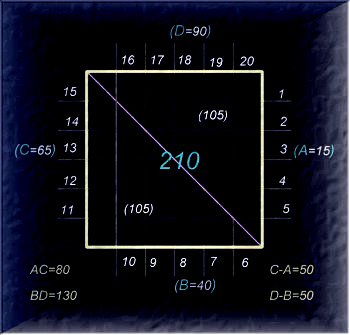
That can be further complicated but again is broken down into the same proportional relationships;
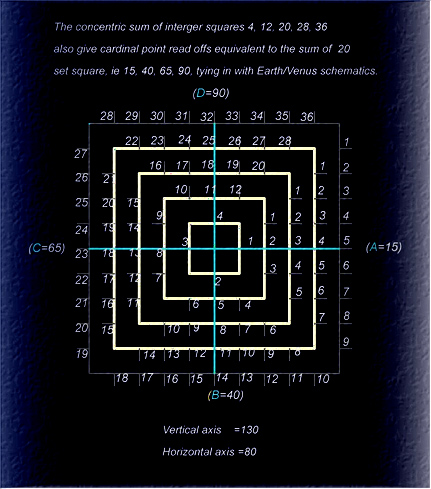
And more complex still;
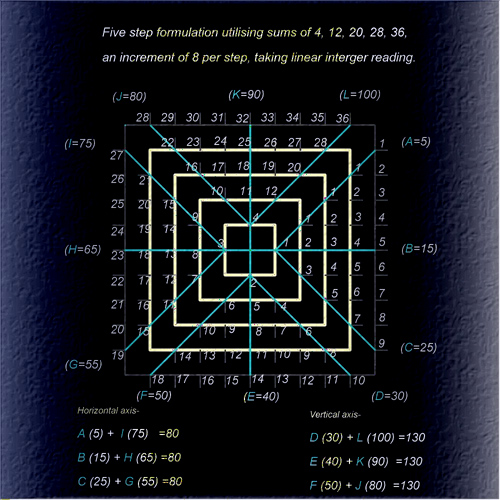
So there was an entire mathamatical tradition that was bound up with the symbolized astronomical relationship introduced by the Apkallu at E-anna which lent itself to being represented in the form of tiered squares and thus the symbolism of the ziggurat, this is were the advanced knowledge lies, the fundamental patterns of nature and creation.
The numerics can also be presented in angular form;

The design of the Great Pyramid has it's basis in the sum of integers of 20 set square, as this is 210 sandstone masonry courses in height (ABCD), has shafts leading toward the 90th level (D) from the 'Queens Chamber' and shafts leading toward the 105th level (B+C)&(A+D) from the 'Kings Chamber' the respective chambers are set on the 25th course (D-C) and (B-A) and upon the 50th course (C-A) & (D-B).
So anyway suffice to say the Apkallu were no slouches when it came to doing sums.
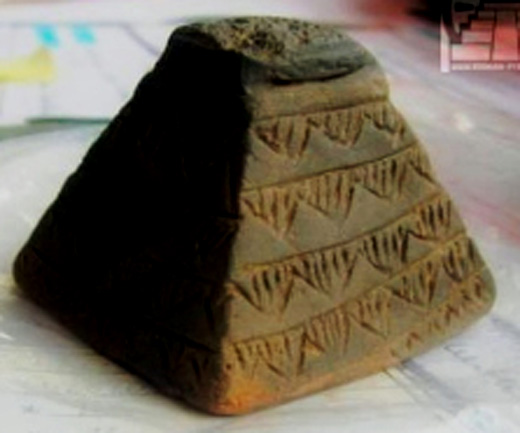
It represents a relationship between two planets, Earth and Venus, a mathamatical relationship expressed through time and space were Venus is seen to appear at a 1/5th subdivision of the ecliptic plane every 584 days,were 584 x 5 = 2,920 days and 2,920/365=8 Earth orbits, thus the cycle over eight Earth years and correspondingly 2,920/224.6=13 Venus orbits, thus a relationship between the numbers 8 and 13.
Cycles = Earth years = Venus orbits = (Earth+Venus) = (Venus-Earth)
1..............8...................13.......................21...................5
5.............40...................65.....................105..................25
10............80..................130....................210..................50
It's generally noted that the numerics of the Earth-Venus cycle are those of the Fibonacci sequence a key pattern within nature and that does indicate the generative associations of the Inanna cult, but there is also a probably not entirely unrelated mathamatical relationship between running counts of the sum of integers when set square, which suggests a deeper relationship within mathamatics, very mysterious that can only be observed.
So for example i set square a running count of the sum of integers of 20 which is 210 and the sum totals and differentials break down according to 10 Earth-Venus cycles;

That can be further complicated but again is broken down into the same proportional relationships;

And more complex still;

So there was an entire mathamatical tradition that was bound up with the symbolized astronomical relationship introduced by the Apkallu at E-anna which lent itself to being represented in the form of tiered squares and thus the symbolism of the ziggurat, this is were the advanced knowledge lies, the fundamental patterns of nature and creation.
The numerics can also be presented in angular form;

The design of the Great Pyramid has it's basis in the sum of integers of 20 set square, as this is 210 sandstone masonry courses in height (ABCD), has shafts leading toward the 90th level (D) from the 'Queens Chamber' and shafts leading toward the 105th level (B+C)&(A+D) from the 'Kings Chamber' the respective chambers are set on the 25th course (D-C) and (B-A) and upon the 50th course (C-A) & (D-B).
So anyway suffice to say the Apkallu were no slouches when it came to doing sums.

Wow that is really fascinating, and I wish I understood more of what you said ha! But yes a lot of architecture, mythology, symbolism is completely
explainable by art. Its really beautiful in a way... however, for the ziggurat being a stepped pyramid in relation to a function of the motion of
venus, i think its far simpler. Having larger bases than the summit gives one a stable platform able to hold weight, and thus allows you to build
higher... its just a simple shape that enabled them to build high structures with the materials of the time.
I read in another book about Sumeria how they worshipped mountains, and the popular theory that ziggurats were manmade representations of sacred mountains. Makes sense to me
I read in another book about Sumeria how they worshipped mountains, and the popular theory that ziggurats were manmade representations of sacred mountains. Makes sense to me
a reply to: Ridhya
The ziggurat related very directly to Venus as the various levels were colour coded according to the five known planets and Sun and Moon and for each of these Venus was seen as the ruling overall principle;
If Venus wears a black crown - Saturn stands in front of her
If Venus wears a white crown - Jupiter stands in front of her
If Venus wears a green crown - Mars stands in front of her
If Venus wears a red crown - Mercury stands in front of her
If Venus wears a rainbow crown - a rainbow lies crosswise in front of her
If Venus wears the Sun's crown - she becomes very bright, Saturn stands in front of her
If Venus wears the Moon's crown - she is very small, Mercury stands in front of her
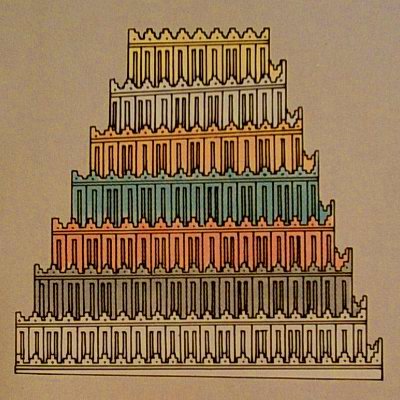
So Venus wearing the rainbow crown or Inanna wearing the rainbow necklace indicated this primacy, the normative symbolic colour for Venus herself was Lapis Lazuli, as a sky Goddess.

Of course as the ziggurat stood upon the Earth then that established the relationship between Earth and the Venusian symbolism.
The ziggurat related very directly to Venus as the various levels were colour coded according to the five known planets and Sun and Moon and for each of these Venus was seen as the ruling overall principle;
If Venus wears a black crown - Saturn stands in front of her
If Venus wears a white crown - Jupiter stands in front of her
If Venus wears a green crown - Mars stands in front of her
If Venus wears a red crown - Mercury stands in front of her
If Venus wears a rainbow crown - a rainbow lies crosswise in front of her
If Venus wears the Sun's crown - she becomes very bright, Saturn stands in front of her
If Venus wears the Moon's crown - she is very small, Mercury stands in front of her

So Venus wearing the rainbow crown or Inanna wearing the rainbow necklace indicated this primacy, the normative symbolic colour for Venus herself was Lapis Lazuli, as a sky Goddess.

Of course as the ziggurat stood upon the Earth then that established the relationship between Earth and the Venusian symbolism.
edit on Kam831223vAmerica/ChicagoTuesday1231 by Kantzveldt because: (no reason given)
a reply to: Kantzveldt
That is very fascinating, BUT! I do believe that the first (Sumerian) ziggurats were much smaller! They werent as large in area or having as many levels. So I do believe that at least the original ones were simply trying to build the highest structure possible, using a simple stable structure.
But you're right about the later ones... I never realised that before. Does that mean that the later (Babylonians?) simply took a Sumerian building and applied astronomical meaning to it? Did it always have meaning but as they observed more planets they added more steps?
And also interesting, reminds me of that description of atlantis by Plato where they built with different colours... only one I remember off hand is the red 'orikalkum'. Im intrigued!
That is very fascinating, BUT! I do believe that the first (Sumerian) ziggurats were much smaller! They werent as large in area or having as many levels. So I do believe that at least the original ones were simply trying to build the highest structure possible, using a simple stable structure.
But you're right about the later ones... I never realised that before. Does that mean that the later (Babylonians?) simply took a Sumerian building and applied astronomical meaning to it? Did it always have meaning but as they observed more planets they added more steps?
And also interesting, reminds me of that description of atlantis by Plato where they built with different colours... only one I remember off hand is the red 'orikalkum'. Im intrigued!
edit on 13-8-2014 by Ridhya because: (no reason given)
a reply to: Ridhya
It is interesting here's a reconstruction of the ziggurat of Marduk from Babylon with astrological colour coding;
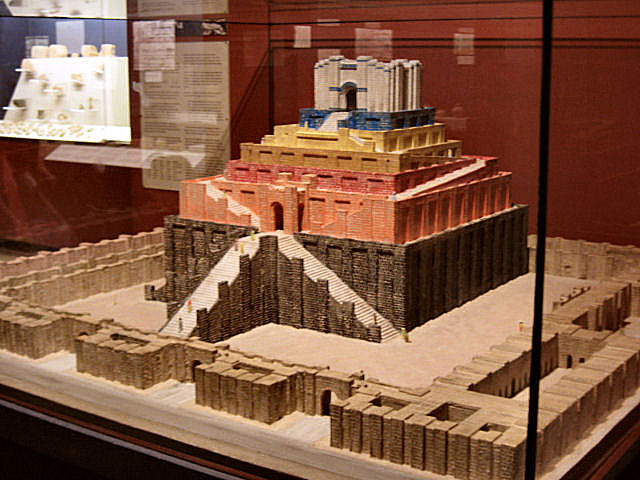
With regards to starting smaller i agree, i think one finds similar progression with the Egyptians were initially they contented themselves with the mastaba which represented the first mound of creation that arose from the celestial waters, but above that developed the empirical mountain of creation and once they had the means they went on to re-create such magical mountains of the horizon.
The basis for this mystical mountain was the zodiacal light seen before dusk and dawn as an effect of the ecliptic plane, and given the relationship of the sun, moon and planets to the ecliptic plane then not surprisingly they could be seen as key symbolic aspects of it.
It is interesting here's a reconstruction of the ziggurat of Marduk from Babylon with astrological colour coding;

With regards to starting smaller i agree, i think one finds similar progression with the Egyptians were initially they contented themselves with the mastaba which represented the first mound of creation that arose from the celestial waters, but above that developed the empirical mountain of creation and once they had the means they went on to re-create such magical mountains of the horizon.
The basis for this mystical mountain was the zodiacal light seen before dusk and dawn as an effect of the ecliptic plane, and given the relationship of the sun, moon and planets to the ecliptic plane then not surprisingly they could be seen as key symbolic aspects of it.
edit on Kpm831224vAmerica/ChicagoWednesday1331 by Kantzveldt because: (no reason given)
new topics
-
Maestro Benedetto
Literature: 52 minutes ago -
Is AI Better Than the Hollywood Elite?
Movies: 1 hours ago -
Las Vegas UFO Spotting Teen Traumatized by Demon Creature in Backyard
Aliens and UFOs: 4 hours ago -
2024 Pigeon Forge Rod Run - On the Strip (Video made for you)
Automotive Discussion: 5 hours ago -
Gaza Terrorists Attack US Humanitarian Pier During Construction
Middle East Issues: 5 hours ago -
The functionality of boldening and italics is clunky and no post char limit warning?
ATS Freshman's Forum: 6 hours ago -
Meadows, Giuliani Among 11 Indicted in Arizona in Latest 2020 Election Subversion Case
Mainstream News: 7 hours ago -
Massachusetts Drag Queen Leads Young Kids in Free Palestine Chant
Social Issues and Civil Unrest: 7 hours ago -
Weinstein's conviction overturned
Mainstream News: 9 hours ago -
Supreme Court Oral Arguments 4.25.2024 - Are PRESIDENTS IMMUNE From Later Being Prosecuted.
Above Politics: 10 hours ago
top topics
-
Krystalnacht on today's most elite Universities?
Social Issues and Civil Unrest: 10 hours ago, 9 flags -
Supreme Court Oral Arguments 4.25.2024 - Are PRESIDENTS IMMUNE From Later Being Prosecuted.
Above Politics: 10 hours ago, 8 flags -
University of Texas Instantly Shuts Down Anti Israel Protests
Education and Media: 13 hours ago, 7 flags -
Weinstein's conviction overturned
Mainstream News: 9 hours ago, 7 flags -
Gaza Terrorists Attack US Humanitarian Pier During Construction
Middle East Issues: 5 hours ago, 7 flags -
Massachusetts Drag Queen Leads Young Kids in Free Palestine Chant
Social Issues and Civil Unrest: 7 hours ago, 6 flags -
Meadows, Giuliani Among 11 Indicted in Arizona in Latest 2020 Election Subversion Case
Mainstream News: 7 hours ago, 5 flags -
Las Vegas UFO Spotting Teen Traumatized by Demon Creature in Backyard
Aliens and UFOs: 4 hours ago, 4 flags -
2024 Pigeon Forge Rod Run - On the Strip (Video made for you)
Automotive Discussion: 5 hours ago, 2 flags -
Any one suspicious of fever promotions events, major investor Goldman Sachs card only.
The Gray Area: 15 hours ago, 2 flags
active topics
-
VP's Secret Service agent brawls with other agents at Andrews
Mainstream News • 60 • : CarlLaFong -
University of Texas Instantly Shuts Down Anti Israel Protests
Education and Media • 228 • : cherokeetroy -
SETI chief says US has no evidence for alien technology. 'And we never have'
Aliens and UFOs • 72 • : yuppa -
My Poor Avocado Plant.
General Chit Chat • 77 • : JonnyC555 -
New whistleblower Jason Sands speaks on Twitter Spaces last night.
Aliens and UFOs • 61 • : Ophiuchus1 -
Is AI Better Than the Hollywood Elite?
Movies • 2 • : 5thHead -
Gaza Terrorists Attack US Humanitarian Pier During Construction
Middle East Issues • 25 • : CarlLaFong -
Mood Music Part VI
Music • 3102 • : Hellmutt -
Las Vegas UFO Spotting Teen Traumatized by Demon Creature in Backyard
Aliens and UFOs • 9 • : Ophiuchus1 -
British TV Presenter Refuses To Use Guest's Preferred Pronouns
Education and Media • 164 • : Annee
11
